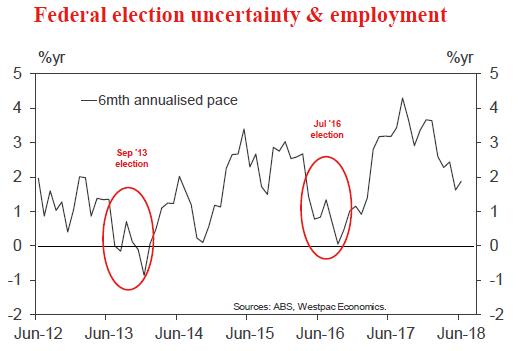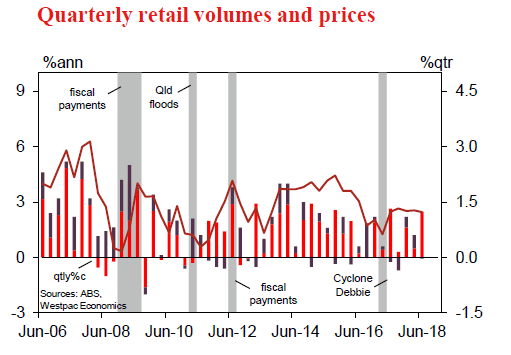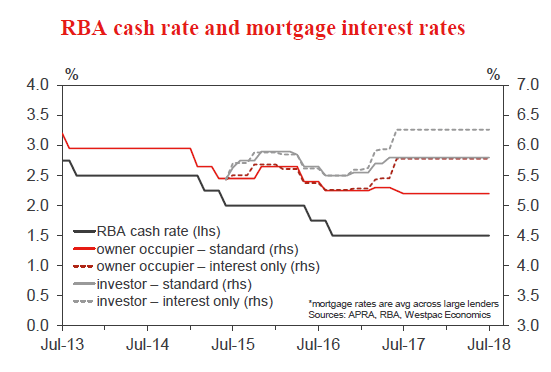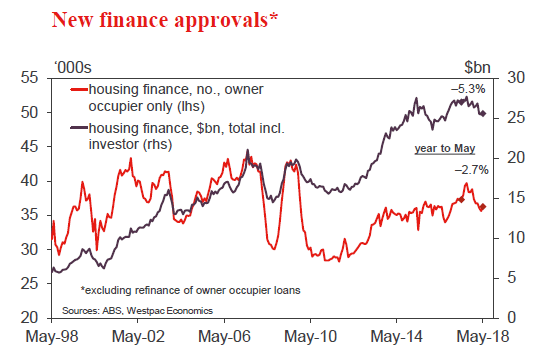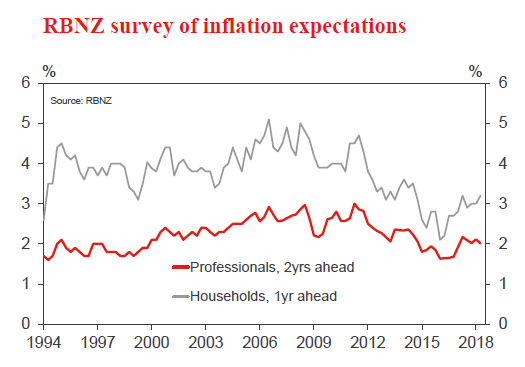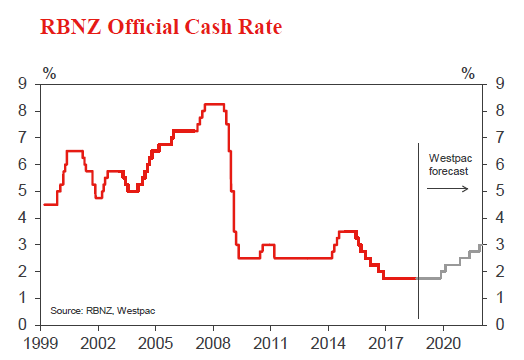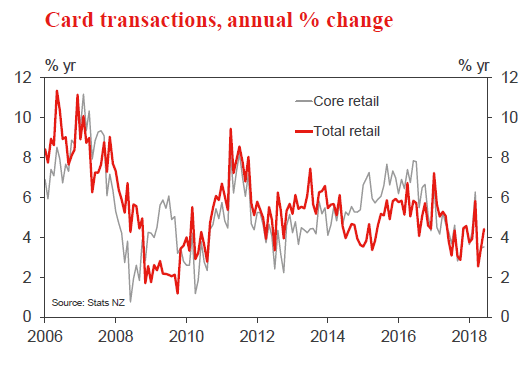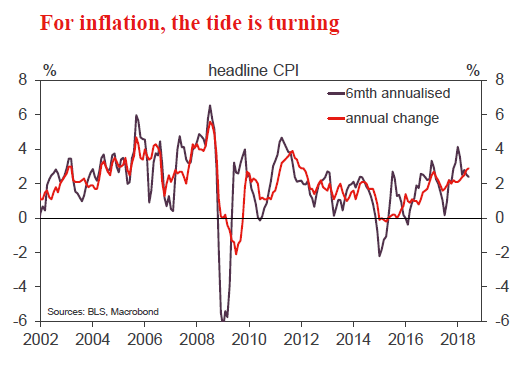Week beginning 6 August 2018
- Political uncertainty casts doubt on the RBA’s optimistic employment forecasts.
- Australia: RBA policy decision, Governor Lowe speech, Statement on Monetary Policy, housing finance.
- NZ: RBNZ policy decision, inflation expectations, retail card spending.
- China: CPI, new loans, trade balance.
- US: CPI.
- Central banks: BOJ Summary of Opinions, BSP and BOT policy decisions.
- Key economic & financial forecasts.
Information contained in this report current as at 3 August 2018.
Political uncertainty casts doubt on the RBA’s optimistic employment forecasts
The Reserve Bank Board meets next week on August 7.
It is certain to keep the overnight cash rate unchanged at 1.5%.
While the decision will be accompanied by the usual statement from the Governor the more interesting development for the RBA will be the release of the detailed (around 70 pages) Statement on Monetary Policy on August 10.
The Statement is always interesting because it includes the Bank’s updated forecasts for GDP; headline and underlying inflation; and the unemployment rate.
In addition there will be an extension of the forecast period to cover the year to December 2020 from the May Statement which only covered forecasts to the end June 2020.
On GDP we expect the Bank will retain its upbeat forecast for growth to December 2018 of 3.25% (recall that the March quarter saw growth of 1.0%) – a view that is particularly underpinned by a positive outlook for employment. We discuss some risks below.
It is also likely to retain the 2.75% forecast for the year to June 2018 implying the Bank expects growth of around 0.6% in the June quarter. On the basis of the 1.6% for the first half of 2018 the second half will need to average around 0.8 percentage points per quarter to achieve the 3.25% forecast.
Westpac is more circumspect expecting 0.5 percentage points for the June quarter and an average of around 0.6 percentage points for the September and December quarters to achieve an annual growth rate of 2.7% for 2018.
Recall that the March quarter was boosted by a contribution from net exports of 0.35 percentage points whereas the partials are pointing to a notably smaller contribution from net exports in the June quarter.
From our perspective the more important structural signal from the March accounts was the choppy performance of household consumption (an insipid 0.34% growth in household consumption following a strong 1% in the December quarter).
By retaining the 3.25% growth forecast for 2018 there is no reason to believe that the Bank will be dissuaded from its 3.25% forecast for 2019.
The current forecast for the year to June 2020 is a modest slowdown to 3% presumably reflecting a peak in the boost from LNG exports and a likely modest drag from housing construction. We would expect the Bank to extend that 3% forecast for the full year to 2020.
So the important point is that the Bank is expecting GDP growth to be above potential for three consecutive years, with potential judged to be around 2.75%. A reasonable outcome from such persistently above trend growth would be to see the output gap close sufficiently to generate some lift in inflation and a marked fall in the unemployment rate.
In that regard the Bank’s forecasts are cautious. In May it forecast underlying inflation to remain “stuck” at 2% for 2018; 2019; and only reach 2.25% in the year out to June 2020.
With the June quarter Inflation Report confirming that annual underlying inflation remained “stuck” around 2% there will be no reason to change the inflation forecasts in the May SOMP with the forecast being extended to December 2020 and underlying inflation to end 2020 being forecast at 2.25% – that is finally inside the 2–3% band but still below the 2.5% “target”. In the May SOMP the Bank stated that “employment growth is expected to be a little above growth in the working age population over the next couple of years and spare capacity is expected to decline.” That “decline” in spare capacity is the dynamic supporting official forecasts that wages growth is expected to reach 3.25% by 2019/20, (Commonwealth Budget May 2018).
The Bank’s forecasts for working aged population growth are 1.7% for 2016 and 1.6% for 2019.
The forecasts for the unemployment rate in the May SOMP of 5.5% by December 2018; 5.25% by December 2019; and 5.25% by June 2020 are expected to be extended to December 2020 at 5.25%.
There is one serious dynamic that could well derail these comfortable jobs forecasts.
Figure 1, shows the profile of employment growth around the “window” of the last two Federal election campaigns. Note how over the nine month “windows” around election campaigns six month annualised employment growth collapsed–a far cry from the RBA’s assumption of “a little above working age population growth (1.6%)”.
It is true that such a pattern has not been apparent during some previous election campaigns but the evidence from 2013 and 2016 must be disturbing.
With the recent by-election results it now seems certain that there will be no early election. The latest possible date for the next election is May 18 2019 (assuming a simultaneous election for the House of Representatives and a half Senate election).
In the previous two elections (2013 and 2016) the election result was arguably more certain than in 2019. For the 2019 election the polls; the by-election results; and the government’s slim one seat majority all point to considerable political uncertainty.
If businesses acted cautiously during the lead up and the aftermath of the last two Federal elections then we cannot rule out a repeat in 2019. Certainly the Bank’s assumption of a healthy 1.6% – 1.8% jobs market over that period would be challenged.
We do not expect the RBA to incorporate any such effect in their forecasts but recent history around election periods raises significant uncertainty about the sustainability of the Bank’s employment forecasts and hence their expectation of above trend economic growth.
The week that was
Policy makers have again been the centre of attention this week, with central bank decisions and associated guidance in the US; UK; Japan and India emphasising the disparate conditions faced in different jurisdictions.
It may be the biggest name in monetary policy, but the July/ August meeting of the FOMC was as close to a non-event as can be. The only real conclusion worth drawing is that the confidence the Committee has in the US economy remains resolute despite the growing impact of trade tensions. All aspects of activity in the US economy were described as strong, and clearly there remains a strong belief amongst participants that their 2.0%yr medium-term inflation target will be achieved in a sustainable manner. The end point for this cycle will be determined by where neutral resides. We hold it to be around 2.50%, and so see a peak in the fed funds rate at 2.875% after four more hikes by June 2019. The restrictive effect of this policy stance will be amplified by the impact rate hikes and the growing deficit have on term interest rates, foreshadowed by our forecast for the US 10-year yield to rise from below 3.00% currently to 3.50% by March 2019.
Before turning to Asia, we should also flag that the Bank of England held true to their rhetoric and raised rates at their August meeting in a unanimous 9-0 vote. Yet the overall tone was mildly dovish with the Bank emphasising the “gradual and limited” nature of the tightening cycle and lowering their estimate of the UK’s neutral rate. In that regard, we were against them hiking at this meeting, and hold that this will eventually prove a policy mistake. Inflation is returning to target quicker than anticipated, and momentum in the economy is poor. On top of all that loom the open-ended risks of Brexit, which will come to the fore early next year.
Turning to Asia and the Bank of Japan (BoJ), expectations were high for a change in the stance of policy at the July meeting. A number of changes were made, but arguably these alterations were not entirely consistent with the market’s expectations. At the moment, the global policy skew is towards tighter policy. While the Bank of Japan did increase flexibility around their 0% 10-year JGB yield target by adding yields “may move upward and downward to some extent mainly depending on developments in economic activity and prices” (+- 20bps), this change and the others that accompanied it occurred to give the BoJ greater capacity to sustain their ultra-loose policy. While markets have since tested the upward ‘extent’ of BoJ flexibility, if anything recent developments in the economy and prices have been slightly weaker than previous quarters, arguing for lower yields. Most notably, when fresh food and energy are excluded, annual inflation is a mere 0.2%yr.
Recent central bank actions elsewhere in Asia have been aimed at mitigating global pressures on price (India) and exchange rate (Indonesia) stability. Both India and Indonesia have taken a pro-active approach to policy in the hope that it will minimise the degree of tightening necessary to fend off instability, and thus limit their effect on economic growth. So far, so good, with activity indicators such as the PMI’s pointing to developing Asia sustaining momentum as advanced economies in the region slow. In the middle is China, showing resilience in manufacturing and service activity. External demand has softened, but it seems unlikely to experience a further jolt lower absent a material escalation of trade tensions with the US. Importantly, having lagged activity for some time, employment in both sectors is now holding up as production momentum eases back. Job and income opportunities are critical for China’s future, both with respect to headline growth as well as their long-term financial and economic stability.
Looking ahead, the RBA is set to meet for their August meeting next week on Tuesday and then release the August Statement on Monetary Policy (SoMP) on Friday. Ahead of these events, Chief Economist Bill Evans has assessed the risks to the RBA’s economic forecasts, the latest iteration of which will be included in the August SoMP. Westpac expects the RBA’s 2018 and 2019 forecasts for growth and inflation to be unchanged, and for the extended horizon to December 2020 to show an expectation of progress towards a lift in inflation off the bottom of their 2–3%yr target range. More significant than these forecasts however are the risks we see to employment growth as the next Federal election nears. The 2013 and 2016 election experience highlights the potential impact political uncertainty can have on job creation and hence activity growth. While the RBA will not incorporate these risks in their forecasts, to us they represent a real challenge to the RBA’s belief in above-trend growth in 2019, and instead argue in favour of our own view of sub-trend growth, circa 2.5%yr. In the interim, the housing market is likely to remain the key area of uncertainty. CoreLogic price data to July show prices declining at a 5% annualised pace in Sydney and Melbourne. Furthermore, we estimate that just over 80% of all dwellings recorded a price decline in the month, well up on the 50% that have seen price declines over the year. Arguably this is evidence of changes to lending standards now affecting a greater proportion of borrowers.
Chart of the week: Q2 real and nominal retail sales
The June retail report posted a third consecutive 0.4% gain, above expectations of a slightly softer 0.3% for June. However, the big surprise was around real retail sales for the quarter, which posted a 1.2% increase vs consensus expectations of a 0.8% gain. Recall that retailers had a difficult March quarter with sales rising just 0.2% and the wider consumer spending measures in the national accounts showing a similarly disappointing outcome. The Q2 rebound in retail volumes suggests much of this is quarterly ‘choppiness’ rather than a move to a weaker underlying trend.
For Q2 as a whole the main surprise for us was around prices. The CPI detail had pointed to a modest 0.2% gain in retail prices. Instead they recorded a 0.1% dip, all store-type categories except cafes & restaurants recording declines. Food price inflation in the survey continues to track 1.5ppts below the CPI measure suggesting consumers are shifting spending patterns towards items/retailers with the most aggressive price discounting. Non food price inflation is more in line with upstream cost measures.
New Zealand: week ahead & data wrap
Working through the details
Business confidence surveys are painting an increasingly dismal picture of the state of the economy. But that hasn’t been reflected in firms’ actions – employment continues to grow at a solid pace, and if anything has regained some momentum in the last quarter. We think this should leave the Reserve Bank broadly satisfied that both employment and inflation remain on track with its mandate.
The ANZ business confidence survey continued its slide in July, reaching levels that were last seen around the time of the 2008- 09 financial crisis. The weakness in confidence is more or less equally spread across the major sectors, suggesting a more general malaise rather than particular challenges facing certain industries.
We’ve noted before that this survey has a political slant: the level of confidence tends to be lower under Labour-led governments, relative to economic conditions at the time. However, the direction of the survey is cause for concern. Confidence has entered a renewed decline after a brief rebound in the early part of this year.
The question is whether businesses’ expressed pessimism will translate into action. There has been only modest evidence for this to date. Growth in job advertisements has slowed, and imports of plant and machinery have eased off in the last few months, but both measures remain at high levels.
Our view is that the pace of growth in the economy has passed its peak, but the weakness in business confidence overstates the case.
Even with an impending fillip from increased government spending, growth in the coming years is likely to remain below the peaks seen in the middle of this decade, as the economy’s spare capacity disappears and net migration slows. However, this represents a slowdown in growth from unsustainably high levels, rather than anything resembling a recession.
We expected to see some sign of the growth slowdown coming through, with a lag, in this week’s labour market figures. But despite a slightly softer headline result, the details of the surveys were surprisingly robust.
The unemployment rate rose slightly in the June quarter to 4.5%, against expectations of a steady rate of 4.4%. That’s not a significant change given the historic volatility of the unemployment rate, and the reasons behind it weren’t alarming: employment grew by 0.5%, but was outstripped by a rise in labour force participation.
We’ve noted previously that recent changes to the Household Labour Force Survey (HLFS) have introduced a seasonal bias, where June quarters tend to be understated. So it’s likely that employment growth was even stronger than the headline figures suggest. That’s apparent from the fact that annual employment growth accelerated to 3.7% in June, compared to 3.1% in March. The employer-focused Quarterly Employment Survey (QES) showed a similar acceleration in jobs growth. (Incidentally, the QES is a direct input to some of the services components of GDP, so these results put some upside risk on our forecast of a 0.7% rise in June quarter GDP.)
The Labour Cost Index (LCI) was also in the spotlight ahead of this week’s releases. Anecdotes suggest that some of businesses’ recent angst stems from the difficulty of finding workers and the resulting pressure to lift pay rates.
The private sector LCI measure was up 2.1% in the last year, compared to 1.9% last quarter. Some of the pickup was due to a larger minimum wage increase this year compared to previous years. But there does seem to have been a lift in private sector wage growth beyond this – not a big change, but this is a very slow-moving series, so we wouldn’t have expected more than what we got at this point.
The labour market surveys are particularly important to the Reserve Bank, now that employment outcomes are part of its mandate along with price stability. We think the RBNZ should be comfortable on both fronts, ahead of next Thursday’s Monetary Policy Statement. The economy continues to run close to ‘maximum sustainable employment’, notwithstanding the small uptick in the unemployment rate this quarter. And the message from the wages data is similar to that from the inflation figures last month: underlying wage and price pressures are gradually picking up, though they are still on the lower side of what would be consistent with the RBNZ’s inflation target.
The balance of those factors argues for keeping the OCR at a low level for a considerable period of time. In its May MPS the RBNZ’s forecasts showed an unchanged OCR through until late 2019, and gradual increases thereafter. However, the language of the statement emphasised that the next move in the OCR could be in either direction, if required by changing conditions.
We expect that language to be retained in next week’s review. Economic developments in the past three months have been mixed: growth has been softer than expected in the near term, but underlying inflation has been a little stronger. House prices have softened in the last few months, and the international environment looks a little more hazardous as the US’s various trade spats heat up. But the lower New Zealand dollar provides something of a buffer to exporters.
If anything, there is a risk of a slightly more dovish tone to the statement compared to May, reflecting the RBNZ’s judgement on fiscal policy. In the June OCR review we were surprised that the RBNZ regarded the 2018 Budget as less stimulatory, in contrast to the Treasury’s view that it was more stimulatory. We suspect the RBNZ will stick to its view, but up to now there hasn’t been an opportunity to elaborate on it.
Our view remains that the next move in the OCR will be up, but not until the end of 2019. Financial markets, which for some time were picking an earlier rate hike, have now fallen into line with our view. A slightly more dovish tone to next week’s statement would likely produce very little market reaction.
Data Previews
Aus RBA policy decision
- Aug 7, Last: 1.50%, WBC f/c: 1.50%
- Mkt f/c: 1.50%, Range: 1.50% to 1.50%
The RBA is certain to keep the overnight cash rate unchanged at 1.5% at its August policy meeting. The Governor’s decision statement is also likely to retain the key line that: “further progress in reducing unemployment and having inflation return to target is expected, although this progress is likely to be gradual”.
This month’s decision will be followed by the release of updated commentary and forecasts with the RBA’s Statement on Monetary Policy on Aug 10. We expect the Bank to retain its upbeat 3.25% growth forecasts for both 2018 and 2019. There will be more interest around the trajectory for inflation, with current forecasts only just nudging into the 2-3% target band by June 2020 but the August update extending that forecast horizon to December 2020. See p2 for a further discussion of the risks around policy. Note that the RBA Governor is also scheduled to speak on Aug 8, the topic being “Demographic Change and Recent Monetary Policy”.
Aus Jun housing finance (no.)
- Aug 8, Last: 1.1%, WBC f/c: –1.0%
- Mkt f/c: 0.0%, Range: -2.0% to 2.0%
Australian housing finance approvals were firmer than expected in May, the number of owner occupier loans rising 1.1% and the value of investor loans up 0.1% in the month. The result was against the wider ‘run of play’ for housing markets – auction activity and prices both pointing to a further softening through the middle of the year.
Finance approvals should reconnect with the wider market picture in June although specific indicators are a bit mixed. Industry data covering the major banks suggest seasonally adjusted approvals posted a rise in June, but were much weaker than the ABS figures in May. Other indicators tracking wider mortgage activity look to have better captured the May resilience and point to some softening in June that accelerated in July. Overall we expect owner occupier finance approvals to show a 1% decline with a clearer weakening showing through in July. Note that as well as more stringent lending criteria, some of this will reflect delays due to longer processing times.
NZ Q3 RBNZ survey of inflation expectations
- Aug 8, Two years ahead, last: 2.01%
The latest RBNZ expectations survey was held soon after the June quarter CPI result. While headline inflation was a touch softer than expected in June, core inflation measures point to a firming in underlying pressures centred on the more persistent non–tradable components. On top of that, there have been some well publicised price increases (e.g. petrol), as well as growing concern about Government policy and rising costs.
Inflation expectations in this and other surveys have lifted from the lows we saw in 2016/17 and are now at levels consistent with the RBNZ’s 2% target mid–point. Most other surveys have pointed towards a further firming recently.
NZ RBNZ Official Cash Rate decision and Monetary Policy Statement
- Aug 9, Last: +1.75%, WBC f/c: +1.75%, Mkt: 1.75%
We expect that the RBNZ will keep the Official Cash Rate unchanged at its August policy meeting. The economy has delivered mixed messages recently, with growth slowing but inflation pressures rising. These forces will broadly offset one another in the RBNZ’s thinking.
The RBNZ is likely to retain its policy outlook from recent meetings, and will signal that the OCR is expected to remain at its current low level for a long while. The forecast track for the OCR will likely be unchanged, or perhaps a tiny smidgen lower. We expect the RBNZ to restate that the next move in the OCR could be “up or down”.
Like us, markets are primed for a neutral to slightly dovish Statement.
NZ Jul retail card spending
- Aug 10, Last: +0.8%, WBC f/c: +0.6%
Smoothing through month–to–month volatility, the first half of 2018 saw the momentum in spending growth fade, with overall retail spending effectively trending sideways since January. In large part, this was due to the slowdown in the housing market and related changes in household spending appetites.
We expect to see spending picking up again through the middle part of the year, with a 0.6% gain expected in June. This is due to increases in government transfer payments, such as Working for Families payments and the accommodation supplement. Nominal spending levels will also be boosted by increases in fuel taxes (though this will limit spending growth in other areas).
US Jul CPI
- Aug 10, last 0.1%, WBC 0.2%
Since February 2018, headline annual CPI inflation has been well in excess of the FOMC’s 2.0%yr inflation target, having risen from 2.2%yr at February to 2.9%yr at June. While in part due to energy prices, core inflation (which exclude food and energy) also moved higher, from 1.8%yr to 2.3%yr.
Shortening the time horizon assessed highlights why the FOMC has not been concerned by these well-above target outcomes. Notably, the six-month annulised pace has eased, from 3.6% to 2.4% for headline inflation and 2.5% to 2.3% for core. The three-month metric suggests a further deceleration will occur in coming months, but likely not quite yet. In July, a 0.2% gain is likely to instead hold up the annual rate.
Looking further ahead, the extent to which CPI inflation holds to target will depend critically on the shelter component – a third of the basket. Private measures of rents are pointing to a material slowing, but this is yet to be seen in the CPI detail.




